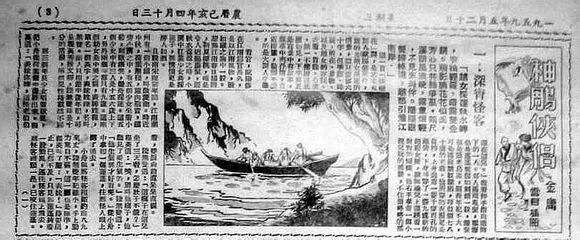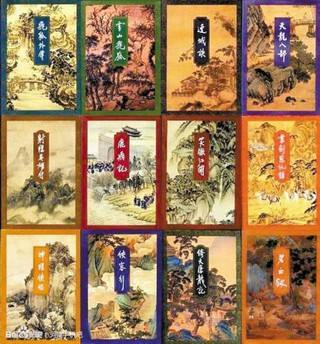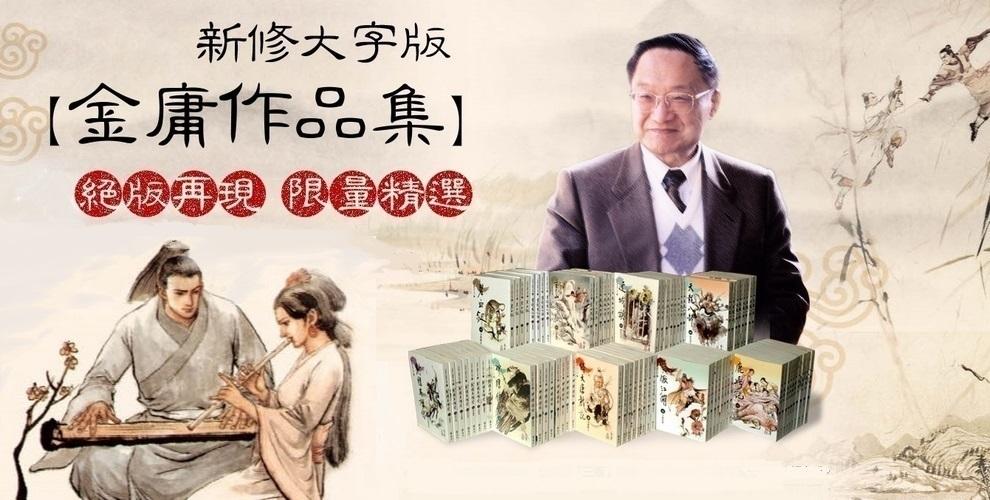Jin Yong novels
Jin Yong wrote a total of fifteen wuxia masterpieces written between 1955 and 1972.
Jin Yong’s wuxia works include fourteen novels and novellas, and the short story Sword of the Yue Maiden.
Most of these stories were initially released as in daily instalments in newspapers with the books being printed after the whole story had been published.
He made two rounds of editing so there are three editions of the novels. Since the novels were initially serialised in newspaper, there was room for improvement hence the first round of edit. The second edit is a result of an accumulation of his own thoughts and feedback from readers.
Contents
- Couplet
- Editions
- Novels
- Sword of the Yue Maiden
- Demi-Gods and Semi-Devils
- The Legend of the Condor Heroes
- The Return of the Condor Heroes
- Heaven Sword and Dragon Sabre
- The Smiling, Proud Wanderer
- Ode to Gallantry
- Sword Stained with Royal Blood
- The Deer and the Cauldron
- A Deadly Secret
- Mandarin Duck Blades
- The Book and the Sword
- Other Tales of the Flying Fox
- Flying Fox of the Snowy Mountain
- White Horse Neighing in the West Wind
Couplet
After all the novels had been published, it was discovered that that first character in the titles of the first fourteen novels formed a couplet. The fifteenth and last book published, Sword of the Yue Maiden, was left out as a couplet needed an even number of characters, and the short story was not considered a novel anyway.
Jin Yong said he never intended for the titles to form a couplet. Nevertheless, it serves as a handy mnemonic for fans to remember the titles of his novels.
Traditional Chinese
飛雪連天射白鹿
笑書神俠倚碧鴛
Simplified Chinese
飞雪连天射白鹿
笑书神侠倚碧鸳
Hanyu Pinyin
Fēi xǚe lián tiān sè bái lù
Xiào shū shén xiá yǐ bì yuān
Translation
Shooting a white deer in the endless drifting snow.
Smiling while writing about the divine chivalrous one leaning against a beautiful lover.
Editions
First edition
Most of Jin Yong’s works were first serialised in Hong Kong newspapers. They were most often published in Ming Pao, which was founded by Jin Yong with his friend. The Return of the Condor Heroes was the first Jin Yong novel to be serialised in Ming Pao, with the first instalment published on 20 May 1959.

Second edition
Due to the nature of serialised works, loopholes and inconsistencies were evident in the first edition. Jin Yong revised his novels between 1970 and 1980 to address these issues. He also removed unnecessary characters and elements.
The revision is referred to by fans as the second edition. It is often published as the “New Edition (新版)” or the “Revised Edition (修訂版)”. The original serialised version is referred to by fans as the first edition, and is sometimes called the “Old Edition (舊版)”.
The second edition carried a preface Jin Yong wrote for the revision.

The novels were first published in China by the Wulin (武林) magazine in Guangzhou from 1980. Jin Yong’s works were published in Simplified Chinese by Beijing’s Joint Publishing (三联书店) in 1994.
Jin Yong’s novels were initially banned in Taiwan. That led to unauthorised underground publications that often revised the novels excessively. His works were eventually published officially by the Yuenching Publishing House (遠景出版社) in 1979.
His novels were published in 1995 in Simplified Chinese by Ming Ho Publications (Singapore-Malaysia branch) (明河社星马分公司) for readers in Southeast Asia.
Third edition
Jin Yong made another round of revisions between 1999 and 2006. This is referred to by fans as the third edition. It is often published as the “New Revised Edition (新修版)” or the “Century New Revised Edition (世紀新修版)”. Some call it the “New, New Edition (新新版)” as a reference to the previous “New Edition”.
Jin Yong included a preface written specifically for the third edition.

The revised novels were published in the order that they were written. The release of final novel, The Deer and the Cauldron, brought an end to the revision in spring 2006.
Jin Yong put in a lot of thought into editing his works, making extensive changes to the personality of characters, the martial arts techniques, and names of locations. The revision also included annotations that addressed criticisms directed at the historical accuracy of the novels.
The drastic changes received mixed reviews from fans. While some embraced the polished revision, others criticised it due to their preference for the plot and names in the earlier editions.
With the release of the third edition, Jin Yong’s publishing company Ming Ho Publications discontinued the second edition.
Novels
Sorted by publish date
- The Book and the Sword
《書劍恩仇錄》(1955–56) - Sword Stained with Royal Blood
《碧血劍》(1956) - The Legend of the Condor Heroes
《射鵰英雄傳》(1957–59) - Fox Volant of the Snowy Mountain
《雪山飛狐》(1959) - The Return of the Condor Heroes
《神鵰俠侶》(1959–61) - Other Tales of the Flying Fox
《飛狐外傳》(1960–61) - White Horse Neighing in the Wind
《白馬嘯西風》(1961) - Mandarin Duck Blades
《鴛鴦刀》(1961) - Heaven Sword and Dragon Sabre
《倚天屠龍記)(1961–63) - A Deadly Secret
《連城訣》(1963) - Demi-Gods and Semi-Devils
《天龍八部》(1963–66) - Ode to Gallantry
《俠客行》(1966–67) - The Smiling, Proud Wanderer
《笑傲江湖》(1967–69) - The Deer and the Cauldron
《鹿鼎記》(1969–72) - Sword of the Yue Maiden
《越女劍》(1970)
Sorted by chronological order of settings
- Sword of the Yue Maiden
《越女劍》(6th century) - Demi-Gods and Semi-Devils
《天龍八部》(11th century) - The Legend of the Condor Heroes
《射鵰英雄傳》(13th century) - The Return of the Condor Heroes
《神鵰俠侶》(13th century) - Heaven Sword and Dragon Sabre
《倚天屠龍記》(14th century) - The Smiling, Proud Wanderer
《笑傲江湖》(16th century) - Ode to Gallantry
《俠客行》(16th century) - Sword Stained with Royal Blood
《碧血劍》(17th century) - The Deer and the Cauldron
《鹿鼎記》(17th century) - A Deadly Secret
《連城訣》(17th century) - Mandarin Duck Blades
《鴛鴦刀》(18th century) - The Book and the Sword
《書劍恩仇錄》(18th century) - Other Tales of the Flying Fox
《飛狐外傳》(18th century) - Flying Fox of the Snowy Mountain
《雪山飛狐》(1780) - White Horse Neighing in the Wind
《白馬嘯西風》(18th century)
Sword of the Yue Maiden
Traditional Chinese title: 越女劍
Simplified Chinese title: 越女剑
Hànyǔ Pīnyīn: Yuè Nǚ Jiàn
Literal meaning: Same as the translated title.
Era: 6th century during the Spring and Autumn Period of ancient China.
Published: First serialised in 1970 in Hong Kong’s Ming Pao Evening Supplement.
Length: 16,445 Chinese characters (Third edition)
Wuxia manual: About | Characters
Fan translation: Read on WuxiaSociety or download the ebooks in EPUB format.
Demi-Gods and Semi-Devils
Alternative title: Eight Races of Deities
Traditional Chinese title: 天龍八部
Simplified Chinese title: 天龙八部
Hànyǔ Pīnyīn: Tiān Lóng Bā Bù
Literal meaning: The Deva, the Nāga, the Eight Sections
Era: 11th century during the Northern Song Dynasty.
Published: First serialised from 3 September 1963 to 27 May 1966 in Hong Kong’s Ming Pao and Singapore’s Nanyang Siang Pau.
Fan translation: Available on WuxiaSociety and in EPUB format.
The Legend of the Condor Heroes
Traditional Chinese title: 射鵰英雄傳
Simplified Chinese title: 射雕英雄传
Hànyǔ Pīnyīn: Shè Diāo Yīng Xióng Zhuàn
Literal meaning: Story of the Eagle-shooting Hero
Era: 13th century during the Southern Song Dynasty and the beginning of the Jurchen-ruled Jin Dynasty’s invasion of northern China.
Published: First serialised from 1 January 1957 to 19 May 1959 in the Hong Kong Commercial Daily.
Fan translation: Available on WuxiaSociety and in EPUB format.
The Return of the Condor Heroes
Traditional Chinese title: 神鵰俠侶
Simplified Chinese title: 神雕侠侣
Hànyǔ Pīnyīn: Shén Diāo Xiá Lǚ
Literal meaning: The Divine Eagle and the Heroic Couple
Era: 13th century during the Southern Song Dynasty and the beginning of the Jurchen-ruled Jin Dynasty’s invasion of ancient northern China.
Published: First serialised from 20 May 1959 to 5 July 1961 in Hong Kong’s Ming Pao.
Fan translation: Available on WuxiaSociety and in EPUB format.
Heaven Sword and Dragon Sabre
Traditional Chinese title: 倚天屠龍記
Simplified Chinese title: 倚天屠龙记
Hànyǔ Pīnyīn: Yǐ Tiān Tú Lóng Jì
Literal meaning: Story of the Heaven Reliant and Dragon Slayer
Era: 14th century during the late Yuan Dynasty in ancient China.
Published: First serialised from 6 July 1961 to 2 September 1963 in Hong Kong’s Ming Pao.
Fan translation: Available on WuxiaSociety and in EPUB format.
The Smiling, Proud Wanderer
Alternative titles: The Wandering Swordsman, State of Divinity, Laughing in the Wind
Traditional Chinese title: 笑傲江湖
Simplified Chinese title: 笑傲江湖
Hànyǔ Pīnyīn: Xiào Ào Jiāng Hú
Literal meaning: Laughing Resolutely in the Jianghu
Era: The author intentionally left the exact time frame of the novel ambiguous. It has been speculated to be set in the 16th century during the Ming Dynasty as the book uses Ming official ranks. In The Deer and the Cauldron, Abbot Chengguan mentioned that “a certain heroic Linghu from the previous dynasty defeated fighting styles without using any style.”
Published: First serialised from 20 April 1967 to 12 October 1969 in Hong Kong’s Ming Pao.
Fan translation: Available on WuxiaSociety and in EPUB format.
Ode to Gallantry
Traditional Chinese title: 俠客行
Simplified Chinese title: 侠客行
Hànyǔ Pīnyīn: Xiá Kè Xíng
Literal meaning: Travels of the Xiake
Era: The exact time frame is not specificed. It has been speculated to be set in the 16th century during the Ming Dynasty based on the Wudang being established and that men did not wear their hair in queues.
Published: First serialised from 11 June 1966 to 19 April 1967 in Hong Kong’s Ming Pao.
Fan translation: Available on the SPCNET forum and in EPUB format.
Sword Stained with Royal Blood
Traditional Chinese title: 碧血劍
Simplified Chinese title: 碧血剑
Hànyǔ Pīnyīn: Bì Xuě Jiàn
Literal meaning: Same as the title.
Era: 17th century during the late Ming Dynasty. Based on the death of Yuan Chonghua, the exact time frame is speculated to be between 1634 to 1644.
Published: First serialised from 1 January 1956 and 31 December 1956 in the Hong Kong Commercial Daily.
Fan translation: Available in EPUB format.
The Deer and the Cauldron
Alternative title: The Duke of Mount Deer
Traditional Chinese title: 鹿鼎記
Simplified Chinese title: 鹿鼎记
Hànyǔ Pīnyīn: Lù Dǐng Jì
Literal meaning: Tale of the Deer and the Cauldron
Era: 17th century during the early Qing Dynasty. The exact time frame is speculated to be between 1670 to 1689 based on the death of historical figure Oboi in 1669 and the signing of the Treaty of Nerchinsk in 1689.
Published: First serialised from 24 October 1969 to 23 September 1972 in Hong Kong’s Ming Pao.
Official translation: John Minford’s version is available on Amazon in book one, book two and book three.
Fan translation: Available on the SPCNET forum and in EPUB format.
A Deadly Secret
Original title: Pure-minded Blade
Original title in traditional Chinese: 素心劍
Original title in simplified Chinese: 素心剑
Original title in Hànyǔ Pīnyīn: Sù Xīn Jiàn
Alternative titles: Requiem of Ling Sing, Secret of the Linked Cities
Traditional Chinese title: 連城訣
Simplified Chinese title: 连城诀
Hànyǔ Pīnyīn: Lián Chéng Jué
Literal meaning: Mnemonic of the Linked Cities
Era: The exact time frame is not stated. Based on the book covers authorised by Jin Yong and the official ranks and location names, it is speculated to be set in the 17th century during the Qing Dynasty.
Published: First published in the Southeast Asia Weekly and Hong Kong’s Ming Pao.
Fan translation: Available on the SPCNET forum and in EPUB format.
Mandarin Duck Blades
Alternative title: Blade-dance of the Two Lovers
Traditional Chinese title: 鴛鴦刀
Simplified Chinese title: 鸳鸯刀
Hànyǔ Pīnyīn: Yuān Yāng Dāo
Literal meaning: Mandarin Ducks Sabers
Era: 18th century during the Qing Dynasty.
Published: First serialised in 1961 in Hong Kong’s Ming Pao.
Length: 37,000 Chinese characters.
Wuxia manual: About | Characters
Translation: Available on WuxiaSociety.
The Book and the Sword
Alternative titles: Book and Sword: Gratitude and Revenge, The Romance of the Book and Sword
Traditional Chinese title: 書劍恩仇錄
Simplified Chinese title: 书剑恩仇录
Era: 18th Century during the Qing Dynasty. The exact time frame is speculated to be in around 1756. In Other Tales of the Flying Fox, Zhao Banshan told a young Hu Fei that Fuk’anggan was once captured by the Red Flower Society twenty years prior”.
Official translation: Graham Earnshaw’s abridged version is available on Amazon.
Fan translation: Available in EPUB format.
Other Tales of the Flying Fox
Traditional Chinese title: 飛狐外傳
Simplified Chinese title: 飞狐外传
Hànyǔ Pīnyīn: Fēi Hú Wài Zhuàn
Literal meaning: Same as the title.
Era: 18th century during the Qing Dynasty. The exact time frame is speculated to be between 1766 to 1770 based on Hu Fei’s age and the date stated in Flying Fox of the Snowy Mountain.
Published: First serialised in 1960 in the Hong Kong magazine Wuxia and History.
Fan translation: Available in EPUB format.
Flying Fox of the Snowy Mountain
Alternative titles: Fox Volant of the Snowy Mountain
Traditional Chinese title: 雪山飛狐
Simplified Chinese title: 雪山飞狐
Hànyǔ Pīnyīn: Xuě Shān Fēi Hú
Literal meaning: Same as the title.
Era: The story begins on 15 March 1780, during reign of the Qianlong Emperor in the Qing Dynasty.
Published: First serialised from 9 February to 18 June 1959 in Hong Kong’s Ming Pao.
Official translation: Olivia Mok’s Fox Volant of the Snowy Mountain is available on Amazon.
Fan translation: Available in EPUB format.
White Horse Neighing in the West Wind
Alternative titles: Swordswoman Riding West on White Horse
Traditional Chinese title: 白馬嘯西風
Simplified Chinese title: 白马啸西风
Hànyǔ Pīnyīn: Bái Mǎ Xiào Xī Fēng
Literal meaning: Same as the title.
Era: 18th century during the Qing Dynasty
Published: First published in 1961 in Hong Kong’s Ming Pao.
Fan translation: Available on WuxiaSociety and in EPUB format.
This site is self-funded by a fan for wuxia fans.
Help keep it running with as little as $0.16 per day.